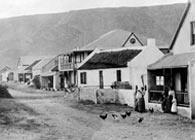Hermanus and its History
“Every town or village name has an origin."
The history of Hermanus dated back to the 1800's – Farmers came by wagon over rugged terrain, down elephant path to the sea in search of good graxing and water for their sheep. The search ended here - where Hermanus is today. They had found their perfect summer retreat…

Above: By 1897 only a few simple houses had been built on the cliff top west of of the Village Hermanuspietersfontein.
Around 70 000 years ago, when the sea level was lower, Middle Stone Age people first lived in the Klipgat Cave (on Hoy’s Koppie above Hermanus). They left remains of their food, fires, and stone tools. Klipgat has also revealed some of the oldest pottery found in South Africa. The 2 000-year-old pieces of pottery were left by San hunter-gatherers. There are also rock paintings and caves to be found at Die Kelders (The Caves) on the southeast side of Walker Bay.
Hermanus Pieters came to South Africa at a time when Dutch-speaking farmers were unhappy about English as a medium of instruction in all government schools. They consequently imported their own teachers from Holland and Germany.
In the year 1815 a lone Dutch teacher, arrived in Table Bay and travelled with the first eastward-bound ox-wagon to Caledon and the farm Boontjieskraal.
Although Pieters mainly taught at Boontjieskraal, one could also assume that he also served farms as far as Karwyderskraal and the Henns at Herriesbaai (today Hawston).
During the summer months, he started herding his flocks of sheep and cattle from Caledon in the 1820’s, down the “Elephant Pass”, now known as the Hemel-en-Aarde valley, down to the coast, where he found good grazing and fresh water. The place eventually became known as “Hermanus Pieters se Fonteyn”.
From then on, the area was named Hermanuspietersfontein, which slowly started to grow into a permanent settlement. (Today) Although the spring that gave the name of Hermanus Pieters to the town is not to be seen easily, the place now have the Hermanus History Display board, Hermanus Pieters Plaque and the 1938 Oxwagon Memorial and various other historical plaques and an artificial fountain to mark the original spring.
The first permanent settlers were the family of Mr. J Michael Henn, who in 1857 with 4 wagon carts, 5 sons, 5 daughters and their various husbands and children, pitched camp right next to the waterfall. They started the fishing industry here and built the first permanent buildings along the present day Marine Drive.
PHOTO AROUND 1930'S

Word of mouth soon took the news of the little village’s "Visbaai" (Fish Bay) with its natural harbour and excellent fishing. Large crowds would gather at “Visbaai” (as the Old Harbour was known), to watch the daily event of fish being carried ashore, gutted and sold while the boats were lifted and put on the turning- stone before being carried up the slipway. Naturally the fresh water spring was a central meeting point and soon the little hamlet of fishermen’s cottages that grew up around it was known as Hermanuspietersfontein.
Eventually the postmaster, a Mr Gift, found the long name too cumbersome. In 1902 he chopped off the latter two thirds of the name and the name became HERMANUS and the village received official municipality status in 1904
The First school (1868) at St Peter’s Mission School, attached to the newly build St. Peter’s church in St’ Peters lane – Between Main Road and marine Drive.
Word spread internationally too, with Harley Street doctors in London, prescribing Hermanus as an ideal location for rest and recuperation with its “champagne air”. A sanatorium was erected in 1896 by Dr. Joshua Hoffman who believed that the favorable climate and fresh air were ideal cure for ailment. The Sanatorium over-looking Walker Bay, from there the term Champaign air, in 1931 the name changed to the Windsor Hotel
The Marine Hermanus built by Walter McFarlane and Valentine Beyers in 1902. Now a five star world class hotel.
The small fishing village also started to attract holiday makers from around the world and grew steadily.
Photo around the 1930's
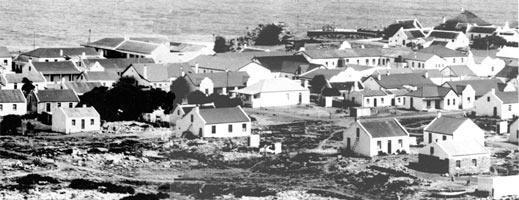
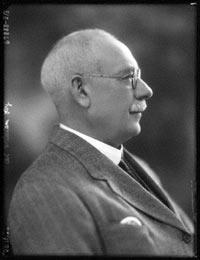 One delightful Hermanus story is regarding Sir William Hoy, who was the head of the South Africa Railways and Harbour Services. Sir William Hoy and his family enjoyed to holiday in Hermanus during the summer and had a great fondness for the small town.
One delightful Hermanus story is regarding Sir William Hoy, who was the head of the South Africa Railways and Harbour Services. Sir William Hoy and his family enjoyed to holiday in Hermanus during the summer and had a great fondness for the small town.
Plans had already been drawn up for the railway line to be extended from the main line at Botrivier, some 35 kms away, down to the coastal town of Hermanus. As such, a railway station was built ready for the trains to arrive, but Sir William Hoy was concerned that the steam trains would not only pollute the fabulously clean air, but also that the town would suddenly be descended upon by 100’s of tourists and hence spoiling the quaintness of this sleepy seaside town.
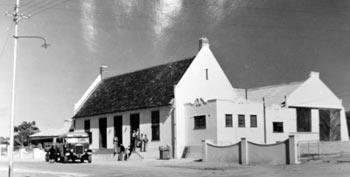 He therefore over-ruled the extension of the railway line and set up a horse and carriage service between the 2 towns. Hence, Hermanus Station is the only railway station in the world to never have had a train arrive or leave from it. The Hermanus Tourism Office now operates from this lovely old building.
He therefore over-ruled the extension of the railway line and set up a horse and carriage service between the 2 towns. Hence, Hermanus Station is the only railway station in the world to never have had a train arrive or leave from it. The Hermanus Tourism Office now operates from this lovely old building.
The Old Fishing Harbour in Hermanus: 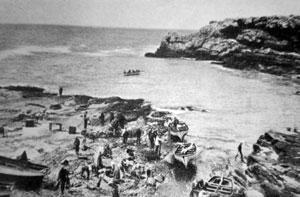
- The Old harbour started around 1855,
- Harbour wall was built in 1904,
- Crane was built in 1915,
- Gutting tables were built in 1935,
- Last fishing boats in Old Harbour 1958
- today The Old Harbour Open Air Museum
Today Hermanus is a scenic town that has stretched along the coastline, hugging the sea and hemmed in by the steep high mountains afew kilometres inland, with Cape Town being only 90 minutes drive away.
Source
- Village by the Sea - Arderne Tredgold
- Old habour Museum (Information and Photos)
- Hermanus Times (around 1960's) - Patterson
- Hermanus Stories I - S.j. du Toit
Call us and schedule your listing today! Contact Us
Copyright © 2024 Hermanus Online Magazine. Web Development by Jaydee media.

